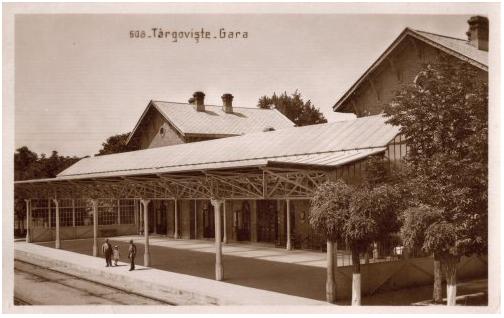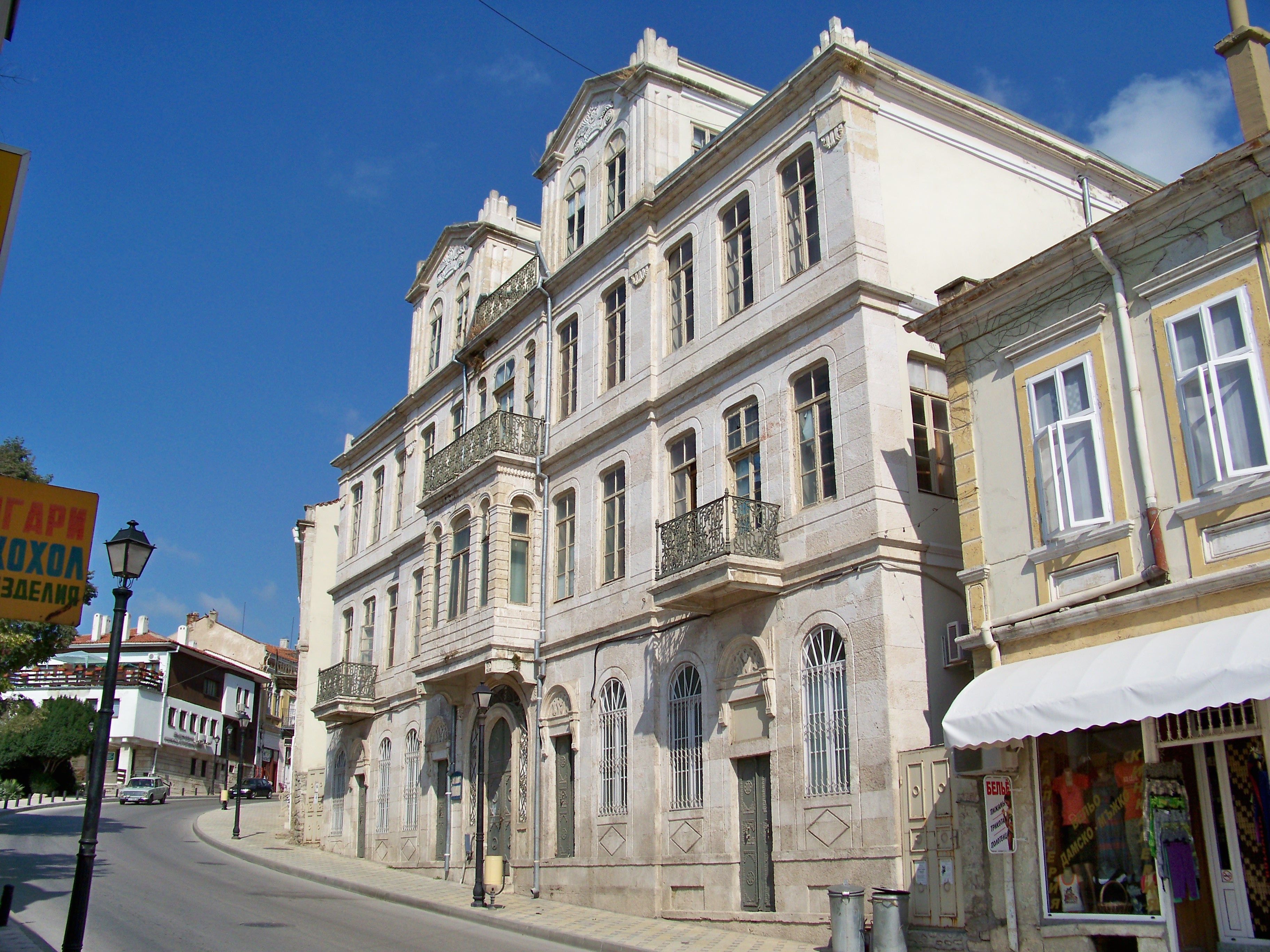|
Târgoviște Art Museum
The Târgoviște Art Museum () is situated on Calea Domnească Târgoviște, Romaniain in close proximity to the Museum of History and the Princely Court. Builging The building stands as one of the significant architectural landmarks of the city from the late 19th century. Constructed between 1892 and 1894 under the stewardship of Italian entrepreneur Giovanni Baltasare Vignosa, it originally served as the seat of the Dâmbovița County Prefecture. The edifice employs a classical architectural style infused with Baroque influences, complemented by an interior adorned with murals. The artwork becomes increasingly ornate in the successive levels, culminating in the highly decorated "Sălii de Consiliu" (Council Room). The mural paintings adorning this central room exhibit motifs inspired by Neoclassicism, botanical elements, and floral designs, strongly influenced by Italian Baroque aesthetics. Above each of the five entrances to the room, there are painted landscapes featuring ... [...More Info...] [...Related Items...] OR: [Wikipedia] [Google] [Baidu] |
Târgoviște
Târgoviște (, alternatively spelled ''Tîrgoviște'') is a Municipiu, city and county seat in Dâmbovița County, Romania. It is situated north-west of Bucharest, on the right bank of the Ialomița (river), Ialomița River. Târgoviște was one of the most important cities in the history of Wallachia, as it was its capital from 1418 to 1659. At the 2021 Romanian census, 2021 census, the city had a population of 66,965 people, making it the 27th largest in the country. Etymology The name ''Târgoviște'' is a Slavic name which the city acquired in the Middle Ages. It is derived from the old Slavonic word for "marketplace", referring to the place rather than the market itself. The name is found in placenames not only in South Slavic areas (Bulgarian , Serbian and Croatian '), but also in West Slavic such as Slovak ''Trhovište'', Czech ''Trhoviště'' or Polish ''Targowica, Lower Silesian Voivodeship, Targowica''. Additionally, places with the same name are found in Romania, ... [...More Info...] [...Related Items...] OR: [Wikipedia] [Google] [Baidu] |
Nicolae Grigorescu
Nicolae Grigorescu (; 15 May 1838 – 21 July 1907) was one of the founders of modern Romanian painting. He is considered by Romanians the greatest Romanian painter, and one of the founders of modern Romanian art. He is most known for paintings depicting rural life. He was one of the most respected and internationally known painters from Romania. There is a metro station named after Grigorescu in Bucharest. It was given his name in 1990, before which it was named after Communist army general Leontin Sălăjan. Romanian currency features Grigorescu on the 10 Lei bank note. Early life He was born in Pitaru, Dâmbovița County, as the sixth of the seven children of Ion Grigorescu (died 1845) and tailor Ruxandra Grigorescu. Wallachia now called Romania. In 1843 his family moved to Bucharest. At a young age, his father, Ion Grigorescu, died when Nicolae was 7. In 1848, he became an apprentice at the workshop of the Romanian painter of Czech origins Anton Chladek and create ... [...More Info...] [...Related Items...] OR: [Wikipedia] [Google] [Baidu] |
Tempera
Tempera (), also known as egg tempera, is a permanent, fast-drying painting medium consisting of pigments mixed with a water-soluble binder medium, usually glutinous material such as egg yolk. ''Tempera'' also refers to the paintings done in this medium. Tempera paintings are very long-lasting, and examples from the first century AD still exist. Egg tempera was a primary method of painting until after 1500 when it was superseded by oil painting. A paint consisting of pigment and binder commonly used in the United States as poster paint is also often referred to as "tempera paint", although the binders in this paint are different from traditional tempera paint. Etymology The term ''tempera'' is derived from the Italian ''dipingere a tempera'' ("paint in distemper"), from the Late Latin ''distemperare'' ("mix thoroughly"). History Tempera painting has been found on early Egyptian sarcophagus decorations. Many of the Fayum mummy portraits use tempera, sometimes in comb ... [...More Info...] [...Related Items...] OR: [Wikipedia] [Google] [Baidu] |
Second World War
World War II or the Second World War (1 September 1939 – 2 September 1945) was a World war, global conflict between two coalitions: the Allies of World War II, Allies and the Axis powers. World War II by country, Nearly all of the world's countries participated, with many nations mobilising all resources in pursuit of total war. Tanks in World War II, Tanks and Air warfare of World War II, aircraft played major roles, enabling the strategic bombing of cities and delivery of the Atomic bombings of Hiroshima and Nagasaki, first and only nuclear weapons ever used in war. World War II is the List of wars by death toll, deadliest conflict in history, causing World War II casualties, the death of 70 to 85 million people, more than half of whom were civilians. Millions died in genocides, including the Holocaust, and by massacres, starvation, and disease. After the Allied victory, Allied-occupied Germany, Germany, Allied-occupied Austria, Austria, Occupation of Japan, Japan, a ... [...More Info...] [...Related Items...] OR: [Wikipedia] [Google] [Baidu] |
Balcic
Balchik ( ; , ) is a List of cities and towns in Bulgaria, town and seaside resort on the Bulgarian Black Sea Coast in the Southern Dobruja area of northeastern Bulgaria. It is in Dobrich Province, 35 km southeast of Dobrich and 42 km northeast of Varna, Bulgaria, Varna. It sprawls scenically along hilly terraces descending from the Dobruja plateau to the sea, and is often called "The White City" because of its white cliffs. Etymology Under the Ottoman Empire, the town came to be known with its present name, which perhaps derived from a Gagauz language, Gagauz word meaning "small town". Another theory suggests that it is named after the medieval ruler Balik (ruler), Balik, brother of Dobrotitsa, after whom the city of Dobrich is named. History Antiquity: Thracians and Greeks Founded as a Thracian settlement, it was later colonised by the List of ancient Greek tribes, ancient Greek Ionians with the name Krounoi (), later renamed as Dionysopolis () after the discovery o ... [...More Info...] [...Related Items...] OR: [Wikipedia] [Google] [Baidu] |




